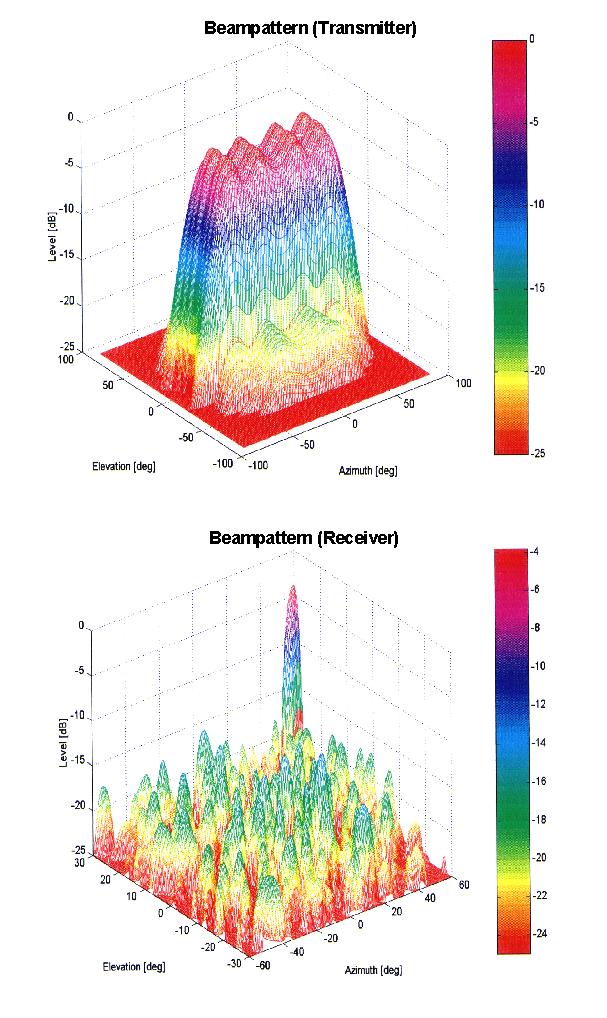Primary objective of
this particular field of research is to apply the basic physical knowledge of
mechanical vibration and wave theory for designing transducers for sound generation and
reception.
The spectral domain of interest ranges from low-frequency transducers, utilized in seismics and in
passive sonars, up to ultrasonic transducers that are used in acoustical imaging
systems of medical diagnostics, imaging sonar tech- nology, and non-destructive
material testing.
The application of ever-improving measurement data processing algorithms requires a higher
information capacity of the measured signals and therefore an improved response characteristic of
future transducers particularly with regard to their bandwidth. The design
of such transducers requires complex simulation tools based on
the Finite Elements Method (FEM).
For this reason
the
research activities within the scope of sensor technology is focused on
adaptation
and application of commercial available FEM-tools to
design transducers with high quality and bandwidth and to optimize
the arrangement of transducer groups regarding the mutual
interactions of neighboring transducers and the acoustical
coupling of the transducers to the propagation medium.
Design of
hydroacoustic Sensor Arrays (Antennas)
A sensor group
(antenna) is a geometrical arrangement of individual transducers. By applying a
special processing to the single transducer signals (Beamforming) it is
possible to only receive signals from acoustic sources whose sound waves are
coming from directions that are lying within a predefined solid angular range (Spatial
Filtering)
Application areas of beamforming are sensor groups in radar and sonar engineering
as well as in seismic exploration and mobile communication. The spatial
filtering effect depends on the assembling of the sensor group, i.e. the number
and the geometrical arrangement of the transducers. The spatial filtering effect
of beamforming depends on the design of the sensor group, i.e. the number and
the geometrical arrangement of the transducers.
The objective of designing 1D, 2D and 3D antennas is the determination
of a transducer arrangement that provides the claimed transmit/receive beampattern
either by employing the smallest possible number of transducers or by using an optimized
amplitude and phase shading of the individual transducers.
Since this class of optimization problems can be solved with the known,
in particular with derivation-based methods, e.g. the gradient and
Newton-Raphson method, only unsatisfactorily (convergent properties) or not at
all (differen- tiability requirements), alternative optimization methods have to be
developed.
Research objectives are therefore the development of new and the
application of robust optimization algorithms for antenna design. As promising
optimization strategies, the genetic algorithm resulting from the theory of
evolution as well as the simulated annealing method derived from solid-state
physics are considered.
The sensor signals of
acoustical imaging systems can have a dynamic range of more than 160 dB. With
available analog-to-digital converters (ADC), however, only a dynamic range of
up to 120 dB can be achieved. In order to be able to sample and digitize the
sensor signals undistorted, an optimum control of the ADC by means of a signal-dependent
gain control is necessary.
For this reason hydroacoustic
sensor systems use a so-called automatic gain control (AGC). In this case, the
gain is adjusted as a function of the estimated instantaneous signal power. The
control speed is essentially determined by the integration time for the power
estimation. While large integration times lead to a sluggish and thus
unadjusted control behavior, significant signal components might be filtered
out by integration times that are too short.
An alternative to the
AGC is the use of a time-variable gain (TVG). For a TVG, a fixed amplifier
characteristic curve is used during each measurement cycle. In order to follow
the changes in the sound propagation conditions adequately, an adaptation of
the characteristic curve from measurement cycle to measurement cycle should
also be possible. In this generalized case one also speaks of an
Adaptive-Time-Variable-Gain (ATVG).
Based on the
fundamentals for the digitization of analogue signals, the research focuses on
specific topics for the optimization of the signal pre-processing chain
consisting of preamplifiers, AGC and/or ATVG, mixers, anti-aliasing and pre-whitening
filters as well as ADC.


